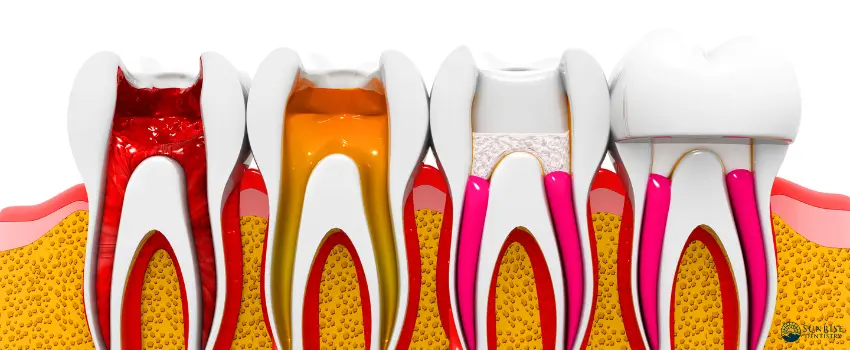When bacteria penetrate the pulp of a tooth and cause infection, common dental procedures may not be enough to restore the health of your smile. In severe cases, your dentist may suggest root canal therapy as a solution.
While the prospect of undergoing root canal treatment was dreaded for its excruciating pain, the latest medical advancements, and the availability of effective local anesthetics, this procedure has now made a more comfortable and pain-free experience. Here’s when root canal treatment is necessary to save your natural teeth and prevent potential dental complications in the future.
What is root canal therapy?
Dental root canals are tiny, hollow spaces within a tooth that contain nerves, blood vessels, and connective tissues. When the pulp within the root canal undergoes inflammation or infection, typically resulting from an injury, deep cavity, or crack, it may lead to swelling, sensitivity, and intense discomfort. If left untreated, the infection can spread to the surrounding tissues and even lead to tooth loss.
Root canal therapy involves removing the infected or damaged pulp, cleaning the root canal, and filling it with a biocompatible material to prevent reinfection. The procedure usually takes one or two appointments, and the tooth is restored with a filling or a crown.
Several factors can cause the need for root canal procedure. Here’s what causes root canal:
- a deep decay or a cavity that has spread to the pulp;
- trauma or injury to the tooth;
- a cracked or fractured tooth;
- repeated dental procedures on the same tooth; or
- gum disease
Pros and Cons of Root Canal Procedure

Dental root canal treatment is an effective procedure that can save a damaged or infected tooth from extraction. However, like any other medical treatment, it has its advantages and disadvantages. Let’s take a closer look at the pros and cons of dental root canal:
Pros:
- Root canal treatment allows you to keep your natural teeth, preventing the need for artificial tooth replacement options such as dentures or implants.
- Root canal procedure can effectively alleviate pain and discomfort caused by an infected or damaged tooth.
- By removing the infected or damaged pulp, root canal treatment prevents the spread of infection to other teeth and gums.
- Root canal procedure has a high success rate, and patients can expect their treated tooth to last for many years.
Cons:
- Root canal treatment typically requires more than one appointment, which can be inconvenient for some patients.
- Root canal surgery can be more expensive than other dental procedures, especially if a specialist is involved.
- Some patients may experience discomfort or sensitivity after root canal, although this typically subsides within a few days. In rare cases, patients may experience persistent pain, swelling, or infection after the procedure.
While this treatment is generally safe and effective, it’s essential to consider the potential root canal treatment side effects and long-term risks before deciding whether to undergo the procedure. Your dentist can provide you with more information about the benefits and drawbacks of root canal and help you make an informed decision about your dental care.
Signs You Need a Root Canal
Root canal treatment is a common procedure, but not everyone requires it. Knowing the signs that may indicate this treatment is necessary to avoid further complications and protect your oral health. Here are some common indicators that suggest you may need this dental procedure:
1. Persistent Pain
Intense pain is a clear indication that something is wrong with your tooth. If you experience sharp, shooting, or throbbing pain in your tooth, especially when you bite down or apply pressure, it could be a sign that the pulp inside the tooth is infected or damaged. It’s essential to get it checked by a dentist, as the pain could worsen and spread to other teeth if left untreated.
2. Sensitivity to Heat and Cold
Tooth sensitivity is a common dental problem caused by several factors. However, if the sensitivity lingers after the source of the temperature is removed, this could be a sign that the tooth pulp is infected. This is a clear indication that a root canal may be needed.
3. Swelling and Tenderness in the Gum
If you notice swelling or tenderness in the gum around a specific tooth, this could be a sign of an infection or inflammation in the tooth’s pulp. The swelling and tenderness may be accompanied by redness and cause discomfort in the jaw and face.
4. Tooth Discoloration
A darkening or discoloration of the tooth may indicate the nerve is damaged or dying. If you notice a gray, black, or brownish color on your tooth, it could be a sign of an infected or dying tooth pulp. This discoloration occurs because the blood vessels and nerves in the tooth no longer function correctly.
5. Cracked or Chipped Tooth
A cracked or chipped tooth can expose the pulp, making it vulnerable to infection. This can cause severe pain and sensitivity, especially when eating or drinking. If left untreated, the tooth may become infected, and a root canal may be required to save the tooth.
6. Gum Boils
Also known as a gum abscess, gum boils are small pockets of pus that can form on the gums near the site of an infected tooth. This is a sign that the infection has progressed and requires immediate treatment, such as a root canal.
7. Loose Tooth
If a tooth feels loose or has shifted out of its normal position, it could be a sign of an infection in the root causing the bone around the tooth to deteriorate. A root canal may be necessary to save the natural tooth and prevent further damage.
How is a root canal surgery done?

Root canal procedure may seem an overwhelming process to those unfamiliar with it. But, with the help of a skilled endodontist or experts focusing exclusively on treating dental pulp, patients can approach this therapy with more confidence. Here are the steps involved in root canal treatment:
Step 1: Diagnosis and Administration of Local Anesthetic
The root canal procedure begins with a thorough diagnosis by a licensed dentist. X-rays may be required to evaluate the extent of the damage or infection. If a root canal is necessary, you will be referred to an endodontist who specializes in this treatment. The endodontist will administer a local anesthetic to the affected tooth, which may cause a slight burning sensation before becoming completely numb.
Step 2: Removal of Infected Pulp
Once the tooth is numb, the endodontist will use specialized tools to create an access hole and remove the infected or damaged pulp and nerve from the tooth’s root canal. This process also involves cleaning and shaping the root canal to ensure there are no remaining traces of infection.
Step 3: Temporary Filling
After the root canal is cleaned and disinfected, the endodontist will fill and seal the space with gutta-percha, a rubber-like material that protects the tooth from saliva and food particles. In some cases, topical antibiotics may be applied to prevent further infection, or oral antibiotics may be prescribed.
Root Canal Aftercare Tips
After a root canal treatment, it’s crucial to follow proper aftercare measures to promote healing and prevent complications. Here are some essential root canal aftercare tips to keep in mind:
- Take it easy. After the procedure, it’s essential to take it easy and avoid strenuous activities that may increase blood flow to the affected area. Rest for the first few days and avoid any activities that may put pressure on the treated tooth.
- Take the prescribed medication. Your dentist may prescribe pain medication or antibiotics to help with pain and prevent infection. Take them as prescribed and finish the full course of antibiotics to ensure the infection is eliminated.
- Apply ice. Applying ice to the affected area can help reduce swelling and discomfort. Apply an ice pack to the outside of your cheek for 15-20 minutes, several times daily, for the first 48 hours.
- Practice good oral hygiene. Brush and floss your teeth regularly, and rinse your mouth with warm saltwater to reduce any discomfort and help promote healing. Avoid brushing the treated tooth until your dentist gives you the go-ahead.
- Eat soft foods. Stick to soft, easy-to-chew foods for the first few days after your procedure. Avoid crunchy foods that may put pressure on the treated tooth.
- Attend follow-up appointments. Your dentist may want to schedule follow-up appointments to ensure the treatment’s success and monitor your recovery. Be sure to attend all appointments and follow your dentist’s instructions.
The Bottom Line
Root canal therapy can be a vital solution for patients with severely damaged or infected teeth. The treatment can prevent tooth loss and restore oral health, allowing individuals to maintain their natural teeth and avoid the need for more invasive procedures.
Despite the fear surrounding this dental procedure, understanding the signs that indicate the need for this treatment can ensure prompt intervention and a successful outcome. If you are experiencing any of the symptoms mentioned in this guide, it is essential to seek dental care immediately. By doing so, you can save your teeth and preserve your oral health for years to come.
Protect the health of your smile with expert help from Sunrise Dentistry.
The key to maintaining a healthy smile is prevention and prompt treatment of dental issues. So, if you have concerns or questions about root canal treatment, don’t hesitate to talk to our dentist in Durango. We can provide you with the necessary information and guidance you need to ensure that you receive the best care possible. Contact Sunrise Dentistry today and take steps to protect your smile.





